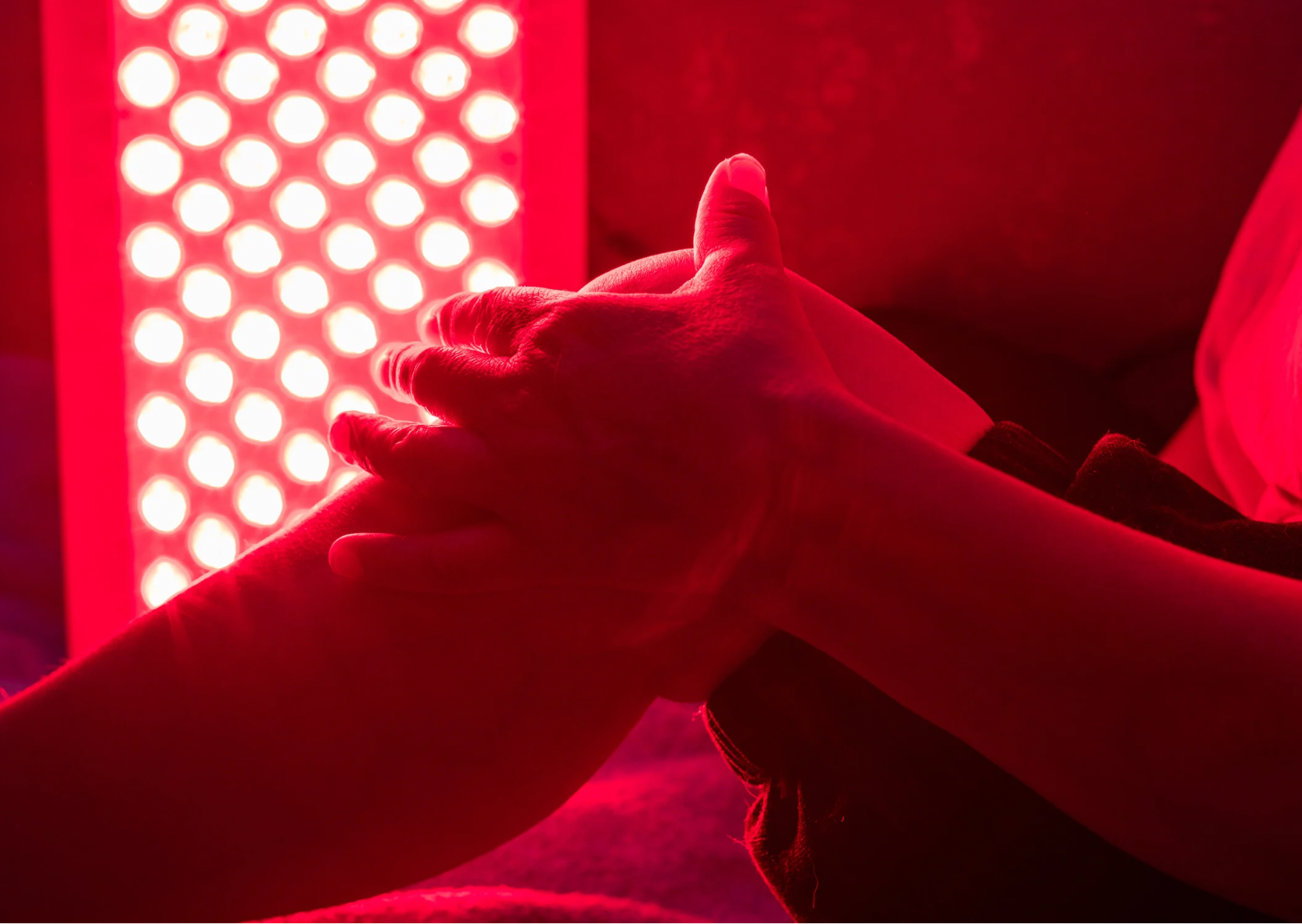Are you tired of mixing collagen powders into your morning smoothie, only to wonder if they're really working?
In this post, we’re exploring an exciting alternative that might revolutionize how we support our body's natural collagen production.
Why collagen is vital
The collagen industry is booming, set to hit $6+ billion by 2025 – but why?
As the most abundant protein in our bodies, collagen isn't just one secret to youthful skin; it's essential for healthy joints, strong bones, and overall ‘structure’ in our bodies.
Since two-thirds of our skin is composed of collagen, it's no surprise that it's essential for maintaining facial elasticity and ensuring smooth skin across the body.
The bad news
Studies show that we can start to lose collagen from our skin in our 20s [1]... and things like stress [2], a high-sugar diet [3], and sun exposure[4] may exacerbate its breakdown.
How? These factors can:
- Increase the activity of enzymes that break down collagen and elastin
- Cause glycation of the skin which interferes with the repair process of collagen
- Decrease the skin's ability to produce new collagen
A healthy collagen balance rests on the rate of collagen degradation and the rate of collagen creation. Winkles, cellulite, broken hair, and brittle nails are all signs of an unhealthy collagen balance.
Natural approaches to boost collagen
Incorporating the following foods into your diet offers one way to maintain a healthy collagen balance.
- High-Quality Proteins: Animal protein sources like fish and poultry are great (opt for regeneratively farmed, pasture-raised, or organic where possible, but you can also get a protein fix through plants. Legumes, soy, nuts, seeds, and quinoa are great options.
- Sulfur-Rich Foods: Think garlic and broccoli for collagen synthesis and supporting detoxification.
- Vitamin C-Rich Foods: Berries, bell peppers, sweet potatoes, and watermelon aren’t just tasty—they’re also packed with vitamin C which our body needs to form collagen and prevent its breakdown
- Omega 3s and Antioxidants: Essential for skin health, find them in chia seeds, flaxseeds, and walnuts. Green Tea & Matcha are also rich in antioxidants like ECGC, which protect the skin.
Collagen Supplements – Worth the Hype?
Scientists have identified up to 29 types of collagen in the body [5], with type I being the most prevalent in skin, bones, and connective tissues. Despite this variety, many collagen supplements do not specify which type they contain.
Most are sold as hydrolyzed collagen peptides, which are essentially pre-digested for better absorption.
You might be surprised to learn that most of the collagen you consume doesn't travel straight from your stomach to your skin. Instead, it gets broken down in your digestive tract into amino acids, which your body then absorbs and uses for various purposes, like building muscle or being reassembled into collagen.
However, studies indicate that some of these smaller peptides, once ingested, may enter the bloodstream and potentially reach the skin, stimulating skin fibroblasts to produce new collagen [6]. This may result in benefits like enhanced skin hydration and elasticity [7, 8].
Here’s the science:
Study #1: A 2017 study [9] found that after taking specific collagen peptides, elevated levels were observed in the bloodstream of human subjects, and also in the skin of a live mouse model.
Study #2: A review of the literature on collagen supplements for skin and orthopedic health suggested that hydrolyzed collagen supplements may reduce wrinkles, and enhance skin elasticity, hydration, and collagen density. In orthopedics, collagen supplements with type I pro-collagen peptides (the collagen found in bones and skin) have shown associations with bone strength, density, joint mobility, and pain reduction. [10]
Study #3: In another study (note: this one was funded by Quiris Healthcare, a producer of organic and herbal health goods including collagen supplements), who tested their drinkable nutraceutical ELASTEN product), 114 women were randomly split into 2 groups to take either hydrolyzed collagen supplements for 8 weeks, or a placebo. Those who took collagen saw a 20% reduction in eye wrinkles, a 65% increase in type I pro-collagen (the collagen found in bones and skin), as well as an 18% increase in elastin (which provides stretch and recoil to the skin). [11]
Study #4: Another placebo-controlled clinical trial involving 105 women found that when type I collagen peptides (supplied by GELITA, a supplier of collagen proteins) were taken for 6 months, noticeable improvements in the appearance of cellulite on the thighs were seen, and “skin became denser, which is a positive sign of skin health improvement”. [12] (Again, note that one of the authors of this study was an employee of GELITA, the company that supplied the collagen supplements.)
What’s the downside?
While the jury is out on the effectiveness of collagen supplements, they have minimal downsides. So if you have some extra funds to spare, it's worth trying them, but make sure to choose carefully….
In 2020, the Clean Label Project [13] tested 28 collagen supplements on the market, and some were found to contain heavy metals like arsenic (64%), cadmium (17%), and lead (33%). Even at low levels, regular consumption could lead to the accumulation of these toxins.
It’s good practice to request heavy metal testing from your collagen supplement provider or consider alternatives like Red Light Therapy (RLT), which may support collagen naturally and safely.
My collagen secret: Red Light Therapy
Imagine tapping into a natural source that enhances your body's ability to build collagen without the powder.
When it comes to healthy collagen in the body, there’s a very important cell involved called fibroblasts. These cells make collagen.
Research shows that laser and LED-based red light therapy may activate these fibroblasts, and may also reduce the breakdown of collagen by inhibiting the activity of enzymes like MMP-1 and MMP-2.
- A randomized, placebo-controlled, double-blind study separated 112 participants into groups to be treated with 633 nm (RED) treatment, 830 nm (NIR) treatment, or both. The LED treatment was at 105 mW/cm2 for RED and 55 mW/cm2 for the NIR, held 1-10 cm away from the face. Participants received light on half of the face for 8 sessions over the course of 4 weeks. 12 weeks after treatment, they saw a statistically significant reduction in wrinkles and improved skin elasticity. After looking at skin specimens, researchers also saw an increase in collagen and elastin fibers (because the light increased the metabolic activity of fibroblasts which secrete collagen). [14]

(Lee, Park, Choi, et al., 2007)
Top: A marked improvement of spider veins was observed in a 55-year-old woman, who had been treated with 830 nm alone (Left: before treatment, Right: 3 months after treatment completion).
Bottom: Clinical photos showing an improvement of periorbital wrinkles 3 months after LED phototherapy (right) compared to the baseline (left)
- Another randomized control study had 113 volunteers treated twice weekly with RED or both RED and NIR light (5 - 25 mW/cm2 irradiance). Compared to the control group, those who received treatment experienced significant improvements in skin complexion and feeling (evaluated with photography and patient satisfaction), roughness (through digital profilometry), and collagen density (measured using ultrasound). [15]

(Weiss, McDaniel, Geronemus, & Weiss, 2005)
Left: Before and After light treatment in a 64-year-old woman (left) and a 41-year-old woman (right).
Right: Collagen ultrasonography samples taken from a 51-year-old woman (top) and a 46-year-old woman (bottom).
-
An in-vitro study showed correlations with a clinical single-blind study [16], investigating the effects of 660nm LED light on collagen synthesis and MPP expression (enzymes that break down collagen).
After 11 sham or LED treatments, the results from the petri dish analysis of human skin “yielded a mean percent difference between LED-treated and non-LED-treated skin of +31% in levels of type-1 pro-collagen (the collagen found in bone and skin) and an 18% decrease in MMP-1”, meaning there was more collagen-building and less breakdown taking place.
In the split-face trial: “more than 90% of individuals showed a reduction in rhytid (wrinkle) depth and surface roughness, and, via a blinded clinical assessment, 87% experienced a reduction in the Fitzpatrick wrinkling severity score after 12 LED treatments.”

(Barolet et al. 2009)
Improvements in skin appearance in aged/photoaged participants with LED treatment versus the control side.
3 steps to healthy collagen:
- 5 minutes of Red Light Therapy on the face and neck (LUMEBOX on RED mode, 5” from the face) alongside a short 5-minute breathing practice
- Your skincare routine (apply sunscreen after red light therapy)
- 1 cup of matcha, paired with oatmeal + 1 cup of berries + 1 tbsp chia seeds
Conclusion
While collagen supplements might seem to offer some benefits, we prefer the long game: eat quality nutrients, protect your skin from UV radiation, and consider safe, non-invasive treatments like red light therapy. By nurturing your body’s natural collagen production, you can enjoy healthy, youthful skin and robust health without unnecessary risks.
New to red light therapy? Download our free eBook to help you choose the best device.
Already have a LUMEBOX? Download our 6 time-saving tricks guide!
Medical Disclaimer: The information contained in this blog post is intended for educational purposes only and should not be used as medical advice. Everyone responds to light differently. Testimonials are not a guarantee of the results you or anyone who uses LUMEBOX will get because your success depends entirely on your circumstances, and the studies on red light therapy shared were not specifically performed using LUMEBOX. Please check with your doctor before using red light therapy and do not change your medical treatments or lifestyle without consulting your physician first.
References:
[1] Ganceviciene, R., Liakou, A. I., Theodoridis, A., Makrantonaki, E., & Zouboulis, C. C. (2012). Skin anti-aging strategies. Dermato-endocrinology, 4(3), 308–319. https://doi.org/10.4161/derm.22804
[2] Mi, Y., Wang, W., Zhang, C., Liu, C., Lu, J., Li, W., Zuo, R., Myatt, L., & Sun, K. (2017). Autophagic Degradation of Collagen 1A1 by Cortisol in Human Amnion Fibroblasts. Endocrinology, 158(4), 1005–1014. https://doi.org/10.1210/en.2016-1829
[3] Danby F. W. (2010). Nutrition and aging skin: sugar and glycation. Clinics in dermatology, 28(4), 409–411. https://doi.org/10.1016/j.clindermatol.2010.03.018
[4] Jariashvili, K., Madhan, B., Brodsky, B., Kuchava, A., Namicheishvili, L., & Metreveli, N. (2012). UV damage of collagen: insights from model collagen peptides. Biopolymers, 97(3), 189–198. https://doi.org/10.1002/bip.21725
[5] Shahrajabian, M. H., & Sun, W. (2024). Mechanism of Action of Collagen and Epidermal Growth Factor: A Review on Theory and Research Methods. Mini reviews in medicinal chemistry, 24(4), 453–477. https://doi.org/10.2174/1389557523666230816090054
[6] Zague, V., de Freitas, V., da Costa Rosa, M., de Castro, G. Á., Jaeger, R. G., & Machado-Santelli, G. M. (2011). Collagen hydrolysate intake increases skin collagen expression and suppresses matrix metalloproteinase 2 activity. Journal of medicinal food, 14(6), 618–624. https://doi.org/10.1089/jmf.2010.0085
[7] de Miranda, R. B., Weimer, P., & Rossi, R. C. (2021). Effects of hydrolyzed collagen supplementation on skin aging: a systematic review and meta-analysis. International journal of dermatology, 60(12), 1449–1461. https://doi.org/10.1111/ijd.15518
[8] Choi, F.D., Sung, C.T., Juhasz, M.L., Mesinkovsk, N.A. (2019). Oral Collagen Supplementation: A systematic review of dermatological applications. Journal of Drugs in Dermatology, Jan 1;18(1):9-16. PMID: 30681787.
[9] Yazaki, M., Ito, Y., Yamada, M., Goulas, S., Teramoto, S., Nakaya, M.-A., Ohno, S., & Yamaguchi, K. (2017). Oral ingestion of collagen hydrolysate leads to the transportation of highly concentrated Gly-Pro-Hyp and its hydrolyzed form of Pro-Hyp into the bloodstream and skin. Journal of Agricultural and Food Chemistry, 65(11), 2315-2322. https://doi.org/10.1021/acs.jafc.6b05679
[10] Campos, L. D., Santos Junior, V. d. A., Pimentel, J. D., Carregã, G. L. F., & Cazarin, C. B. B. (2023). Collagen supplementation in skin and orthopedic diseases: A review of the literature. Heliyon, 9(4), Article e14961. https://doi.org/10.1016/j.heliyon.2023.e14961
[11]Bolke, L., Schlippe, G., Gerß, J., & Voss, W. (2019). A Collagen Supplement Improves Skin Hydration, Elasticity, Roughness, and Density: Results of a Randomized, Placebo-Controlled, Blind Study. Nutrients, 11(10), 2494. https://doi.org/10.3390/nu11102494
[12] Schunck, M., Zague, V., Oesser, S., & Proksch, E. (2015). Dietary supplementation with specific collagen peptides has a body mass index-dependent beneficial effect on cellulite morphology. Journal of Medicinal Food, 18(12). https://doi.org/10.1089/jmf.2015.0022
[13] https://cleanlabelproject.org/wp-content/uploads/Organic-Consumers-Assoc-White-Paper_Updated.pdf
[14] Lee YS , Park K, Choi J, et al. A prospective, randomized, placebo-controlled, double-blinded, and split-face clinical study on LED phototherapy for skin rejuvenation: clinical, profilometric, histologic, ultrastructural, and biochemical evaluations and comparison of three different. J Photochem Photobiol.2007;88:51-67.
[15] Wunsch, A., & Matuschka, K. (2014). A controlled trial to determine the efficacy of red and near-infrared light treatment in patient satisfaction, reduction of fine lines, wrinkles, skin roughness, and intradermal collagen density increase. Photomedicine and laser surgery, 32(2), 93–100. https://doi.org/10.1089/pho.2013.3616
[16] Barolet, D., Roberge, C. J., Auger, F. A., Boucher, A., & Germain, L. (2009). Regulation of skin collagen metabolism in vitro using a pulsed 660 nm LED light source: clinical correlation with a single-blinded study. The Journal of Investigative Dermatology, 129(12), 2751–2759. https://doi.org/10.1038/jid.2009.186




